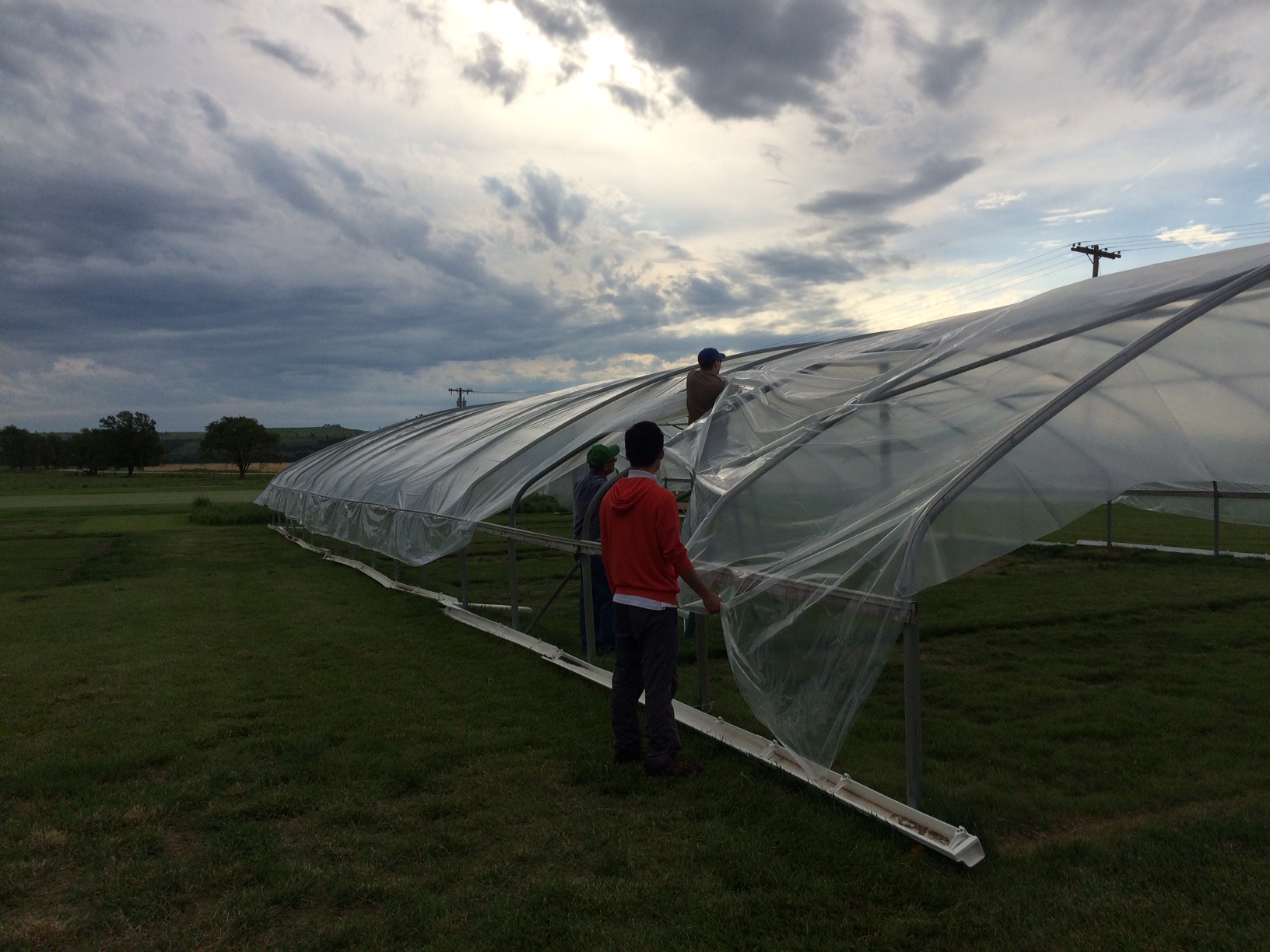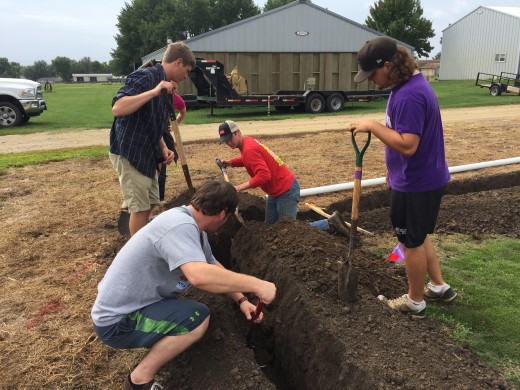(By Jared Hoyle, KSU Turfgrass Research and Extension)
“An ounce of prevention is worth a pound of cure” – Benjamin Franklin
When I start talking about pre-emergent herbicides this quote from Benjamin Franklin always pops in my head. Although, Ben was giving fire-fighting advice to Philadelphians because fires were a dangerous threat at that time it does apply to many things we are dealing with right now, including spreading wild fires. (I won’t comment on that because I have no idea how to manage wild fires.) But I will talk about Pre-remergent herbicides.

Pre-emergent (PRE) herbicides prevent summer annual weed (For Example, crabgrass, goosegrass, annual sedges, and spurge) seeds from developing into mature plants. The reason we use PRE herbicides for summer annual weed control is because these summer annuals come back every year from seeds. So if we can stop the seed from growing then we don’t have to deal with the weeds later in the season.
For all that don’t know how a PRE herbicide works here is a very short explanation. They do not keep the seed from germinating but kill the young germinating plant. With few exceptions they have no effect on existing plants, so they must be applied before germination.
But like in everything in life there is an exception. Dithiopyr can kill crabgrass as long as it is young (two- to three-leaf stage, see photo below of three leaf crabgrass) and still have some residual for continued PRE activity. It doesn’t last as long as some of the other PRE herbicides but there is flexibility if you miss your window of opportunity to apply.

So when do I put out the PRE application for summer annual weed control? Well, it depends on many things. What summer annuals you have? Where are you located in Kansas? Many times turfgrass managers center their PRE applications around crabgrass germination. Crabgrass “typically” begins to germinate around May 1 or a little later in KS. April 15 is a good target date for applying a PRE because it gives active ingredients time to evenly disperse in the soil before crabgrass germination starts. The April 15 target works well for most of the state, but for southeast Kansas April 1 is more appropriate, and for northwest Kansas May 1 is best. Additionally, weather varies from one spring to the next (As we can see this year where it is getting warmer earlier!), and with it the timing of crabgrass germination. Some turfgrass managers base their PRE application around the bloom of the Redbuds but other ways can be used as well. Crabgrass germinates when the soil at approximately 1 cm deep reaches 55° F. So watch your soil temperatures to see when the soil consistently reaches 55° F. Here is a great website that will give you soil temperatures for your area.
http://mesonet.k-state.edu/weather/historical/
PRE herbicides do not last forever once applied to the soil. Microorganisms and natural processes begin to gradually break them down soon after they are applied. If some products are applied too early, they may have lost much of their strength by the time they are needed. Additionally, PRE herbicides have different half-life, Koc, water solubility, and vapor pressure. This can determine how fast microbial, chemical and physical decay occurs along with infiltration, volatilization, leaching, and run-off.

Therefore, not all PRE herbicides are created equal. Here is a list of PRE herbicides, the weeds they target and some concerns that you might want to know before applying.
| Active Ingredient |
Weeds Controlled |
Concerns or Comments |
| benefin |
summer annual grasses, annual bluegrass, some-small seeded broadleaves |
Do not use on golf course greens. |
| prodiamine |
summer annual grasses, annual bluegrass, henbit, chickweed, spurge, some-small seeded broadleaves |
Only apply to well established turfgrass. |
| bensulide |
annual grasses, some broad-leaves |
Do not use on putting greens composed of > 50% Poa annua. |
| florasulam |
broadleaves, dandelion, prickly lettuce, clover |
Packaged with Dimension 2EW, florasulam great cool temperature activity, Prevents flowering in some broadleaves (dandelions). |
| dithiopyr |
summer annual grasses, annual bluegrass, yellow-woodsorrel, some small-seeded broadleaves |
PRE and early post-emergence activity on crabgrass. |
| isoxaben |
broadleaves such as chickweed, henbit, spurge, plantain, others |
Tank-mix with a grass herbicide for broader spectrum. |
| pronamide |
annual bluegrass, perennial ryegrass, other grassy & broadleaf weeds. |
Do not use on cool-season turf. Restricted use pesticide. |
| pendimethalin |
summer annual grasses, annual bluegrass, yellow-woodsorrel, some small-seeded broadleaves |
Not recommended for turf severely thinned due to winter stress. Split applications can be made for extended control. |
| metolachlor |
annual bluegrass, crabgrass, sedges |
Do not use on cool-season turf. |
| simazine |
summer annual grasses, annual bluegrass, henbit, chickweed, spurge, some-small seeded broadleaves |
Do not use on cool-season turf. |
| ethofumesate |
annual bluegrass, annual grasses, some annual broadleaves |
See label for reducing annual bluegrass in cool-season turf. |
| oxadiazon |
summer annual grasses includinggoosegrass, annual bluegrass, some-small seeded broadleaves |
Ronstar G and Oxadiazon 2G are only formulations labeled for use on cool-season turf. |
| indaziflam |
annual grassy and broadleaf weeds in turf |
Do not use on cool-season turf. |
| oryzalin |
summer annual grasses, annual bluegrass, some-small seeded broadleaves |
Do not use on cool-season turf except tall fescue. |
| dimethenamid |
bittercress, crabgrass, goosegrass, purslane, sedges, spurge |
On golf courses: Can be used on cool- and warm-season. Other turf areas: Warm-season only. |
| siduron |
crabgrass, bermudagrass (suppression) |
Does not control goosegrass or annual bluegrass. |
Information in this table was acquired from “Turfgrass Weed Control for Professionals” by A. Patton and D. Weisenberger, Purdue University (and 11 collaborating states including Kansas). For more information about purchasing this publication see;
https://blogs.k-state.edu/turf/new-weed-control-publication-for-turfgrass-professionals/
***There are many combination PRE herbicides that combine these active ingredients with each other and with other POST-emergent herbicides***
Always remember to READ THE LABEL for the correct rate, turfgrass tolerance, and specific instructions before application!!!
***Mention of trade names or commercial products in this article is solely for identification purposes and does not imply recommendation or endorsement, nor is criticism implied of similar products not mentioned by Kansas State University.***
Don’t forget to follow me on twitter @KSUTurf.
Also, visit our facebook page www.facebook.com/KSUTurf













































